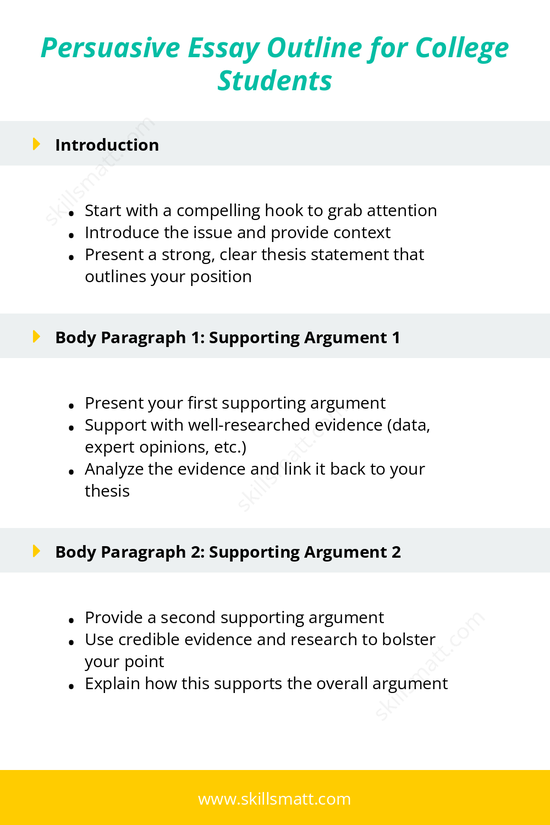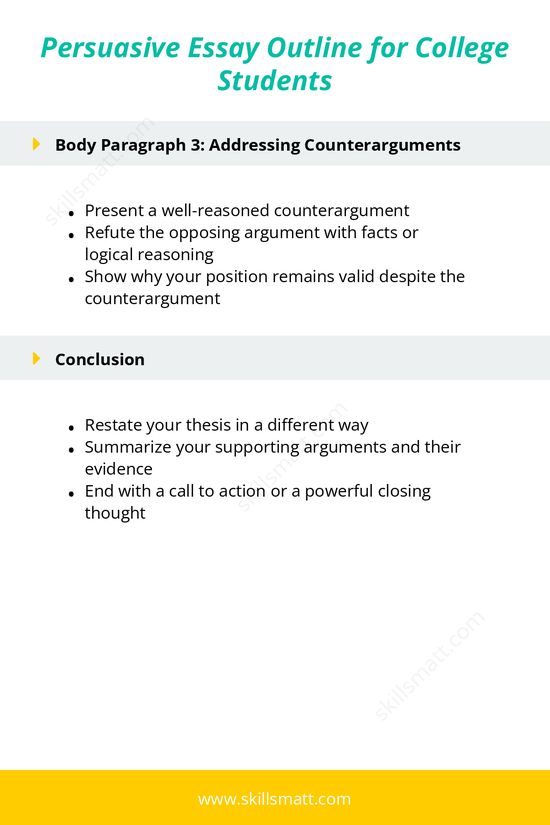Writing a persuasive essay is a vital skill, especially for college students. Persuasive essays are not just about stating your opinion; they require well-reasoned arguments, solid evidence, and a compelling structure to convince the reader of your position. The following outline provides a detailed framework to help college students write persuasive essays that can effectively persuade their audience and present their viewpoints in a clear, logical, and convincing manner.
Introduction
The introduction of your persuasive essay should captivate the reader's attention and provide context for the argument you're about to present. It's the first impression you make on your audience, so it needs to be engaging and thought-provoking.
- Start with a compelling hook to grab attention: Your opening sentence should make the reader want to continue. This could be a striking statistic, an intriguing question, or a relevant anecdote.
- Introduce the issue and provide context: Briefly explain the issue or topic you are addressing. Give your audience the background they need to understand the significance of the argument you're making.
- Present a strong, clear thesis statement that outlines your position: Your thesis should be specific and assertive. Clearly state your stance on the issue and outline the reasons why the reader should agree with your perspective.
Body Paragraph 1: Supporting Argument 1
In this first body paragraph, you will present your strongest supporting argument. This should be a reason that clearly supports your thesis and is backed up by evidence.
- Present your first supporting argument: Start with a clear topic sentence that introduces your first point. This is your main argument in support of your thesis.
- Support with well-researched evidence (data, expert opinions, etc.): Back up your argument with solid evidence. This could include statistical data, expert quotes, or real-world examples that validate your point.
- Analyze the evidence and link it back to your thesis: Don’t just present the evidence—explain how it supports your thesis and strengthens your position.
Body Paragraph 2: Supporting Argument 2
The second body paragraph should introduce another supporting argument. This argument should build on the first one, offering a new perspective or further reinforcing your thesis.
- Provide a second supporting argument: Introduce another point that adds to the strength of your overall argument. Make sure this point is distinct from the first one but still contributes to your thesis.
- Use credible evidence and research to bolster your point: Just like the first paragraph, support this argument with research, data, or expert opinions to make your case stronger.
- Explain how this supports the overall argument: Link this second argument back to your thesis and explain how it helps reinforce your position on the issue.
Body Paragraph 3: Addressing Counterarguments
Addressing counterarguments is an essential part of writing a persuasive essay. It shows that you have considered alternative viewpoints and strengthens your own position by demonstrating why it is more valid.
- Present a well-reasoned counterargument: Acknowledge a valid opposing viewpoint. This helps demonstrate that you are objective and have considered other perspectives.
- Refute the opposing argument with facts or logical reasoning: Provide evidence or reasoning that refutes the counterargument. Explain why the opposing view is less convincing than your own.
- Show why your position remains valid despite the counterargument: After addressing the counterargument, reaffirm why your thesis is still stronger and more convincing.
Conclusion
The conclusion is where you bring everything together. It’s your last chance to make an impact on the reader and leave a lasting impression.
- Restate your thesis in a different way: Don’t simply repeat your thesis verbatim; instead, rephrase it in a way that summarizes the key points you’ve made in the body of your essay.
- Summarize your supporting arguments and their evidence: Briefly review the main arguments you’ve made and the evidence that supports them. This reinforces the validity of your position.
- End with a call to action or a powerful closing thought: End your essay by encouraging your reader to take action, reconsider their viewpoint, or reflect on the significance of your argument. A strong closing thought can leave the reader thinking long after they’ve finished reading.
By following this structured outline, college students can write persuasive essays that not only present compelling arguments but also engage the reader in critical thinking. A well-crafted persuasive essay is more than just a presentation of facts—it’s about making a convincing case that encourages the reader to align with your perspective or take meaningful action on the issue at hand.


